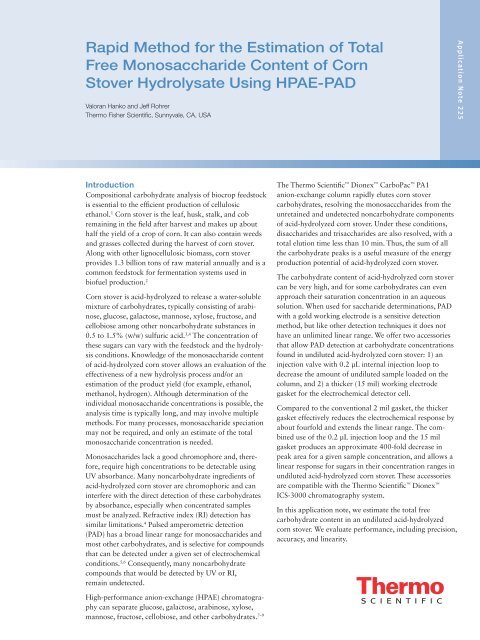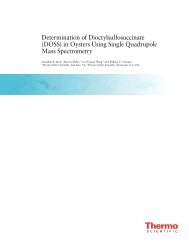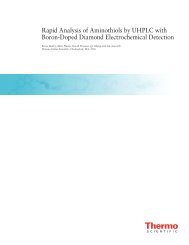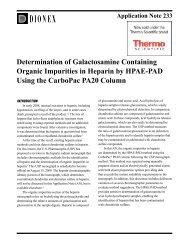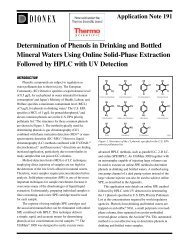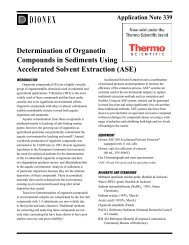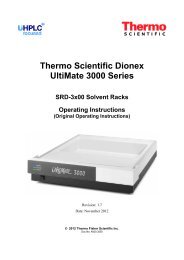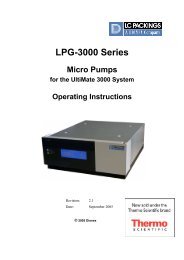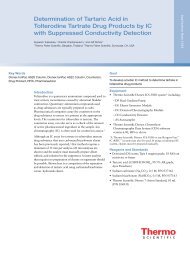Rapid Method for the Estimation of Total Free ... - Dionex
Rapid Method for the Estimation of Total Free ... - Dionex
Rapid Method for the Estimation of Total Free ... - Dionex
Create successful ePaper yourself
Turn your PDF publications into a flip-book with our unique Google optimized e-Paper software.
<strong>Rapid</strong> <strong>Method</strong> <strong>for</strong> <strong>the</strong> <strong>Estimation</strong> <strong>of</strong> <strong>Total</strong><br />
<strong>Free</strong> Monosaccharide Content <strong>of</strong> Corn<br />
Stover Hydrolysate Using HPAE-PAD<br />
Valoran Hanko and Jeff Rohrer<br />
Thermo Fisher Scientific, Sunnyvale, CA, USA<br />
Introduction<br />
Compositional carbohydrate analysis <strong>of</strong> biocrop feedstock<br />
is essential to <strong>the</strong> efficient production <strong>of</strong> cellulosic<br />
ethanol. 1 Corn stover is <strong>the</strong> leaf, husk, stalk, and cob<br />
remaining in <strong>the</strong> field after harvest and makes up about<br />
half <strong>the</strong> yield <strong>of</strong> a crop <strong>of</strong> corn. It can also contain weeds<br />
and grasses collected during <strong>the</strong> harvest <strong>of</strong> corn stover.<br />
Along with o<strong>the</strong>r lignocellulosic biomass, corn stover<br />
provides 1.3 billion tons <strong>of</strong> raw material annually and is a<br />
common feedstock <strong>for</strong> fermentation systems used in<br />
bi<strong>of</strong>uel production. 2<br />
Corn stover is acid-hydrolyzed to release a water-soluble<br />
mixture <strong>of</strong> carbohydrates, typically consisting <strong>of</strong> arabinose,<br />
glucose, galactose, mannose, xylose, fructose, and<br />
cellobiose among o<strong>the</strong>r noncarbohydrate substances in<br />
0.5 to 1.5% (w/w) sulfuric acid. 3,4 The concentration <strong>of</strong><br />
<strong>the</strong>se sugars can vary with <strong>the</strong> feedstock and <strong>the</strong> hydrolysis<br />
conditions. Knowledge <strong>of</strong> <strong>the</strong> monosaccharide content<br />
<strong>of</strong> acid-hydrolyzed corn stover allows an evaluation <strong>of</strong> <strong>the</strong><br />
effectiveness <strong>of</strong> a new hydrolysis process and/or an<br />
estimation <strong>of</strong> <strong>the</strong> product yield (<strong>for</strong> example, ethanol,<br />
methanol, hydrogen). Although determination <strong>of</strong> <strong>the</strong><br />
individual monosaccharide concentrations is possible, <strong>the</strong><br />
analysis time is typically long, and may involve multiple<br />
methods. For many processes, monosaccharide speciation<br />
may not be required, and only an estimate <strong>of</strong> <strong>the</strong> total<br />
monosaccharide concentration is needed.<br />
Monosaccharides lack a good chromophore and, <strong>the</strong>re<strong>for</strong>e,<br />
require high concentrations to be detectable using<br />
UV absorbance. Many noncarbohydrate ingredients <strong>of</strong><br />
acid-hydrolyzed corn stover are chromophoric and can<br />
interfere with <strong>the</strong> direct detection <strong>of</strong> <strong>the</strong>se carbohydrates<br />
by absorbance, especially when concentrated samples<br />
must be analyzed. Refractive index (RI) detection has<br />
similar limitations. 4 Pulsed amperometric detection<br />
(PAD) has a broad linear range <strong>for</strong> monosaccharides and<br />
most o<strong>the</strong>r carbohydrates, and is selective <strong>for</strong> compounds<br />
that can be detected under a given set <strong>of</strong> electrochemical<br />
conditions. 5,6 Consequently, many noncarbohydrate<br />
compounds that would be detected by UV or RI,<br />
remain undetected.<br />
High-per<strong>for</strong>mance anion-exchange (HPAE) chromatography<br />
can separate glucose, galactose, arabinose, xylose,<br />
mannose, fructose, cellobiose, and o<strong>the</strong>r carbohydrates. 7–9<br />
The Thermo Scientific <strong>Dionex</strong> CarboPac PA1<br />
anion-exchange column rapidly elutes corn stover<br />
carbohydrates, resolving <strong>the</strong> monosacccharides from <strong>the</strong><br />
unretained and undetected noncarbohydrate components<br />
<strong>of</strong> acid-hydrolyzed corn stover. Under <strong>the</strong>se conditions,<br />
disaccharides and trisaccharides are also resolved, with a<br />
total elution time less than 10 min. Thus, <strong>the</strong> sum <strong>of</strong> all<br />
<strong>the</strong> carbohydrate peaks is a useful measure <strong>of</strong> <strong>the</strong> energy<br />
production potential <strong>of</strong> acid-hydrolyzed corn stover.<br />
The carbohydrate content <strong>of</strong> acid-hydrolyzed corn stover<br />
can be very high, and <strong>for</strong> some carbohydrates can even<br />
approach <strong>the</strong>ir saturation concentration in an aqueous<br />
solution. When used <strong>for</strong> saccharide determinations, PAD<br />
with a gold working electrode is a sensitive detection<br />
method, but like o<strong>the</strong>r detection techniques it does not<br />
have an unlimited linear range. We <strong>of</strong>fer two accessories<br />
that allow PAD detection at carbohydrate concentrations<br />
found in undiluted acid-hydrolyzed corn stover: 1) an<br />
injection valve with 0.2 µL internal injection loop to<br />
decrease <strong>the</strong> amount <strong>of</strong> undiluted sample loaded on <strong>the</strong><br />
column, and 2) a thicker (15 mil) working electrode<br />
gasket <strong>for</strong> <strong>the</strong> electrochemical detector cell.<br />
Compared to <strong>the</strong> conventional 2 mil gasket, <strong>the</strong> thicker<br />
gasket effectively reduces <strong>the</strong> electrochemical response by<br />
about fourfold and extends <strong>the</strong> linear range. The combined<br />
use <strong>of</strong> <strong>the</strong> 0.2 µL injection loop and <strong>the</strong> 15 mil<br />
gasket produces an approximate 400-fold decrease in<br />
peak area <strong>for</strong> a given sample concentration, and allows a<br />
linear response <strong>for</strong> sugars in <strong>the</strong>ir concentration ranges in<br />
undiluted acid-hydrolyzed corn stover. These accessories<br />
are compatible with <strong>the</strong> Thermo Scientific <strong>Dionex</strong> <br />
ICS-3000 chromatography system.<br />
In this application note, we estimate <strong>the</strong> total free<br />
carbohydrate content in an undiluted acid-hydrolyzed<br />
corn stover. We evaluate per<strong>for</strong>mance, including precision,<br />
accuracy, and linearity.<br />
Application Note 225
2 Equipment<br />
• <strong>Dionex</strong> ICS-3000 system consisting <strong>of</strong>:<br />
– DP or SP Gradient or Isocratic Pump, with vacuum<br />
degas option<br />
– DC Detector Compartment with 6-port high-pressure<br />
inject valve, single or dual zone temperature control<br />
– Electrochemical Detector with Carbohydrate Certified<br />
(Au) PTEF Disposable Electrodes (P/N 066480,<br />
package <strong>of</strong> six), or conventional gold working<br />
electrode (P/N 079850)<br />
– Combination pH/Ag/AgCl reference electrode<br />
(P/N 061879)<br />
– Thermo Scientific <strong>Dionex</strong> AS Autosampler<br />
• High carbohydrate concentration accessories,<br />
consisting <strong>of</strong>:<br />
– 0.2 µL injection loop (Stator Face Seal Kit,<br />
P/N 068383), and<br />
– Amperometry cell gasket, 15 mil thickness<br />
(P/N 057364).<br />
– EO1 Eluent Organizer, including one or more<br />
2 L plastic bottles and pressure regulator<br />
• Thermo Scientific <strong>Dionex</strong> Chromeleon Chromatography<br />
Data System<br />
• Helium 4.5 grade, 99.995%, < 5 ppm oxygen; or<br />
Nitrogen 5.0 ultrahigh purity grade, 99.999%, < 1 ppm<br />
oxygen (Praxair)<br />
• Filter unit, 0.2 µm Nylon (Nalgene ® 90 mm Media Plus,<br />
Nalge Nunc International, P/N 164-0020 or equivalent<br />
nylon filter)<br />
• Vacuum pump (Gast P/N DOA-P104-AA or equivalent)<br />
• 0.3 mL Polypropylene injection vials with caps (Vial Kit,<br />
P/N 055428)<br />
Reagents and Standards<br />
Reagents<br />
• Deionized water, 18 MΩ-cm resistance or higher<br />
• 50% sodium hydroxide (w/w; Fisher Scientific,<br />
P/N SS254-500 recommended)<br />
Standards<br />
• D-Glucose, monohydrate (J.T. Baker, Inc., Cat#<br />
1910-01)<br />
• D(–)-Fructose (J.T. Baker, Inc., Cat# M556-05)<br />
• D(+)-Mannose (Sigma-Aldrich, Cat# M-6020)<br />
• D(+)-Galactose (Sigma-Aldrich, Cat# G-0625)<br />
• D(+)-Cellobiose (Sigma-Aldrich, Cat# C-7252)<br />
• D(–)-Arabinose (Sigma-Aldrich, Cat# A-3131)<br />
• D-Xylose (Sigma-Aldrich, Cat# X107-5)<br />
Conditions<br />
<strong>Method</strong><br />
Columns: <strong>Dionex</strong> CarboPac PA1 Analytical, 4 × 250 mm<br />
(P/N 035391)<br />
Flow Rate: 1.0 mL/min<br />
Inj. Volume: 0.2 µL (full loop)<br />
Temperature: 30 °C<br />
Detection: Pulsed amperometry, gold working electrode,<br />
15 mil gasket<br />
pH: 12.5–12.8<br />
Background: 19–36 nC<br />
Typical System<br />
Operating<br />
Backpressure: 1050–1070 psi<br />
<strong>Method</strong>: 200 mM NaOH; isocratic, 10 min run time,<br />
or longer if needed.<br />
Carbohydrate Wave<strong>for</strong>m <strong>for</strong> <strong>the</strong> ED<br />
Time (s) Potential (V) Integration Gain Region* Ramp*<br />
0.00 +0.1 Off On<br />
0.20 +0.1 Begin On On<br />
0.40 +0.1 End Off On<br />
0.41 –2.0 Off On<br />
0.42 –2.0 Off On<br />
0.43 +0.6 Off On<br />
0.44 –0.1 Off On<br />
0.50 –0.1 Off On<br />
Reference electrode in Ag/AgCl mode.<br />
* Additional wave<strong>for</strong>m commands used in <strong>the</strong> <strong>Dionex</strong><br />
ICS-3000; not used in our older systems.<br />
Preparation <strong>of</strong> Solutions and Reagents<br />
Eluents<br />
It is essential to use high-quality water <strong>of</strong> high-resistivity<br />
(18 MΩ-cm) and containing as little dissolved carbon<br />
dioxide as possible. Biological contamination should be<br />
absent. Source water must be obtained using a water<br />
purification system consisting <strong>of</strong> filters manufactured<br />
without electrochemically active surfactants or o<strong>the</strong>r<br />
compounds (<strong>for</strong> example, glycerol). Prior filtration<br />
through 0.2 µm porosity nylon under vacuum is recommended<br />
to remove particulates and reduce dissolved air.<br />
Keep <strong>the</strong> eluent water blanketed under 34–55 kPa<br />
(5–8 psi) <strong>of</strong> helium or high-purity nitrogen at all times to<br />
reduce diffusion <strong>of</strong> atmospheric carbon dioxide and<br />
opportunistic microorganisms. <strong>Dionex</strong> (now part <strong>of</strong><br />
Thermo Scientific) Technical Note 71 10 provides details <strong>for</strong><br />
good eluent preparation practices.
200 mM Sodium Hydroxide<br />
Combine 20.8 mL <strong>of</strong> 50% sodium hydroxide with 1979 g<br />
<strong>of</strong> vacuum filter-degassed water to make 2 L.<br />
Stock Standards<br />
Solid carbohydrate standards were placed in plastic vials<br />
and dissolved in deionized water to a 200 mg/mL<br />
concentration, except xylose (400 mg/mL). These solutions<br />
were combined and diluted with water to yield<br />
13.9 mg/mL arabinose, 37.7 mg/mL glucose, 209 mg/mL<br />
xylose, 1.31 mg/mL mannose, 5.94 mg/mL galactose,<br />
3.99 mg/mL fructose, and 0.28 mg/mL cellobiose. This<br />
mix was diluted 9:1, 8:2, 7:3, 6:4, 5:5, 4:6, 3:7, 2:8, 1:9;<br />
v:v in water to make <strong>the</strong> concentrations used <strong>for</strong> calibration<br />
and chosen <strong>for</strong> each monosaccharide standard, to<br />
encompass <strong>the</strong> expected concentrations <strong>for</strong> each in<br />
acid-hydrolyzed corn stover. All dilutions were made<br />
gravimetrically to ensure high accuracy, and maintained<br />
frozen at –40 °C until needed. Although a 10-point<br />
calibration was used in this note to detect any nonlinearity,<br />
if present, it is not needed <strong>for</strong> routine use.<br />
(Carbohydrates are hygroscopic. Significant errors due to<br />
moisture content in <strong>the</strong> solids used to make standards<br />
may occur. Drying solids under high vacuum and slightly<br />
elevated heat [<strong>for</strong> example, 40–50 ºC] can significantly<br />
reduce this error <strong>for</strong> some carbohydrates.)<br />
Sample Preparation<br />
Acid-hydrolyzed corn stover acid (pH ~1.8) was donated<br />
by <strong>the</strong> National Renewable Energy Laboratory (NREL). 2<br />
This sample was centrifuged at 16000 × g <strong>for</strong> 10 min to<br />
ensure elimination <strong>of</strong> particulates. The supernatant was<br />
directly injected into <strong>the</strong> HPAE-PAD system <strong>for</strong> analysis.<br />
To assess recovery, <strong>the</strong> supernatant was combined with<br />
<strong>the</strong> highest concentration standard mix in <strong>the</strong> proportion<br />
<strong>of</strong> 9:1, 8:2, 7:3; v:v <strong>of</strong> supernatant to standard.<br />
Results and Discussion<br />
Separation<br />
Figure 1 shows <strong>the</strong> rapid analysis <strong>of</strong> acid-hydrolyzed corn<br />
stover <strong>for</strong> arabinose, glucose, galactose, xylose, mannose,<br />
fructose, cellobiose, and o<strong>the</strong>r carbohydrates using a<br />
<strong>Dionex</strong> CarboPac PA1 column. Panel A shows <strong>the</strong> full<br />
display <strong>of</strong> <strong>the</strong> major carbohydrate peaks <strong>for</strong> both <strong>the</strong><br />
carbohydrate standard mix (chromatogram 1) and <strong>the</strong><br />
undiluted acid-hydrolyzed corn stover (chromatogram 2).<br />
Peak 1 is arabinose, peak 2 is a mixture <strong>of</strong> glucose, xylose,<br />
galactose, and mannose, peak 3 is fructose, and peak 4 is<br />
cellobiose. Panel B reduces <strong>the</strong> range <strong>of</strong> <strong>the</strong> signal axis to<br />
view minor peaks, with alditols, glycols, alcohols, and<br />
Column: <strong>Dionex</strong> CarboPac PA1, 4 mm<br />
Eluent: 200 mM NaOH<br />
Flow Rate: 1.0 mL/min<br />
Column Temp: 30 ºC<br />
Inj. Volume: 0.2 µL<br />
Detection: PAD, Au working electrode, 15 mil gasket,<br />
four-potential carbohydrate wave<strong>for</strong>m.<br />
Samples: 1. Carbohydrate standard mixture<br />
(consisting <strong>of</strong> 10 mg/mL arabinose, 4 mg/mL galactose,<br />
27 mg/mL glucose, 1 mg/mL mannose, 3 mg/mL fructose,<br />
0.2 mg/mL cellobiose, 150 mg/mL xylose)<br />
2. Undiluted acid-hydrolyzed corn stover<br />
Peaks: 1. Arabinose<br />
2. Mannose, glucose, xylose, galactose<br />
3. Fructose*<br />
4. Cellobiose*<br />
*And unidentified substances <strong>for</strong> <strong>the</strong> acid-hydrolyzed corn stover<br />
8,000<br />
nC<br />
–1,250<br />
300<br />
A<br />
B<br />
1<br />
2<br />
1 2<br />
3 4<br />
3<br />
Sample 2<br />
Sample 1<br />
nC<br />
4<br />
Sample 2<br />
Sample 1<br />
–50<br />
0 1 2 3 4 5<br />
Minutes<br />
6 7 8 9 10<br />
26159<br />
Figure 1. Separation <strong>of</strong> undiluted acid-hydrolyzed corn stover sugars.<br />
o<strong>the</strong>r compounds eluting be<strong>for</strong>e arabinose, and oligosaccharides<br />
eluting after fructose. The identities <strong>of</strong> <strong>the</strong>se<br />
minor peaks were not determined; however, Table 1<br />
presents <strong>the</strong> retention times <strong>for</strong> many common carbohydrates<br />
found in plant-derived biomass or fermentation<br />
broths using this method. This isocratic method was<br />
optimized <strong>for</strong> throughput, and thus coelution <strong>of</strong> carbohydrate<br />
species was intended <strong>for</strong> simplification <strong>of</strong> <strong>the</strong><br />
quantification described below. Both fructose (peak 3) and<br />
cellobiose (peak 4) coelute with o<strong>the</strong>r unknown substances<br />
and accurate measurements are not expected <strong>for</strong><br />
<strong>the</strong>se substances.<br />
3
4<br />
Table 1. Retention times* <strong>of</strong> carbohydrates found in plant-derived biomass or<br />
fermentation systems.<br />
Analyte<br />
Retention<br />
Time (min)<br />
Analyte<br />
Retention<br />
Time (min)<br />
Void 1.2 Glucose 2.9<br />
Propylene Glycol 1.3 Xylose 2.9<br />
Glycerol 1.4 Galactose 2.9<br />
myo-Inositol 1.4 Fructose 3.2<br />
Erythritol 1.5 Sorbose 3.2<br />
Xylitol 1.6 Ribose 3.3<br />
Sorbitol 1.8 Melibiose 3.7<br />
Galactitol 1.9 Lactose 4.5<br />
Trehalose 2.2 Sucrose 5.4<br />
Mannosamine 2.3 Turanose 6.2<br />
Galactosamine 2.4 Gentiobiose 6.3<br />
Glucosamine 2.4 Cellobiose 6.5<br />
Arabinose 2.5 Palatinose 6.7<br />
N-Acetylglucosamine † 2.6 Raffinose 8.5<br />
Lyxose 2.7 Maltose 9.2<br />
Mannose 2.7 Maltotriose 27.1<br />
Arabitol 1.7<br />
Ribitol 1.9<br />
Fucose 1.9<br />
Rhamnose 2.1<br />
* <strong>Dionex</strong> CarboPac PA1 column, 200 mM NaOH, 1.0 mL/min, 30 ºC column temperature.<br />
Retention times can vary slightly from this table <strong>for</strong> system-to-system, or day-to-day<br />
operation.<br />
† Not expected in acid-hydrolyzed biomass, but may be present following enzymatic<br />
digestion.<br />
Detection<br />
Linearity<br />
A calibration curve was produced <strong>for</strong> total carbohydrates<br />
injected, using a mixture <strong>of</strong> carbohydrates having <strong>the</strong><br />
same relative concentrations found in acid-hydrolyzed<br />
corn stover, and having total concentrations above and<br />
below that found in this sample. The r 2 <strong>for</strong> total peak area<br />
(peaks 1–4) plotted against <strong>the</strong> total monosaccharide<br />
standard concentration injected was 0.9997. The percent<br />
errors found <strong>for</strong> <strong>the</strong> standards measured against <strong>the</strong><br />
calibration curve ranged from 0–2%, consistent with a<br />
high correlation coefficient.<br />
Accuracy<br />
Three different concentrations <strong>of</strong> a mixture <strong>of</strong> carbohydrate<br />
standards were spiked into acid-hydrolyzed corn<br />
stover. Analyte recoveries were determined from <strong>the</strong> ratio<br />
<strong>of</strong> a measured increase to <strong>the</strong> <strong>the</strong>oretical concentrations<br />
spiked. The recoveries ranged from 80–120% <strong>for</strong> each <strong>of</strong><br />
<strong>the</strong> first four carbohydrate peaks (1–4, Figure 1). Peaks <strong>of</strong><br />
unknown identity in <strong>the</strong> sample, resolved at lower<br />
hydroxide eluent concentrations, coelute with fructose<br />
(peak 3), and cellobiose (peak 4), and prevent accurate<br />
measure <strong>of</strong> <strong>the</strong>se carbohydrates. When <strong>the</strong> total peak area<br />
<strong>of</strong> <strong>the</strong>se four peaks was considered along with <strong>the</strong> total<br />
carbohydrate amounts spiked into acid-hydrolyzed corn<br />
stover, <strong>the</strong> percent recoveries ranged from 85–96%.<br />
The high recovery indicates that in spite <strong>of</strong> <strong>the</strong> poor<br />
accuracy <strong>of</strong> peaks 3 and 4, <strong>the</strong>ir minor contribution to <strong>the</strong><br />
total amounts <strong>of</strong> monosaccharide in <strong>the</strong> corn stover<br />
hydrolysate still enables acceptable estimations <strong>of</strong><br />
monosaccharide (in addition to cellobiose) concentration<br />
in <strong>the</strong>se samples. Because peak 2 contains more than one<br />
monosaccharide, and <strong>the</strong> electrochemical response <strong>for</strong><br />
coeluting sugars will not be a simple sum <strong>of</strong> <strong>the</strong> responses<br />
<strong>for</strong> individual sugars, we evaluated a simple mixture to<br />
estimate <strong>the</strong> error. When <strong>the</strong> ratios <strong>of</strong> glucose:xylose were<br />
0:1, 1:2, 1:1, 2:1, 1:0 (w:w; at a fixed 100 mg/mL total<br />
sugar concentration), <strong>the</strong> peak area response factors<br />
(area/µg injected) were 27.8 ± 0.2, 28.9 ± 0.2, 30.0 ± 0.2,<br />
30.2 ± 0.4, 30.5 ± 0.1 nC*min per µg, respectively<br />
(n = four injections in each treatment). Galactose<br />
(100 mg/mL) was 30.8 ± 0.1 nC*min per µg.<br />
The variation in response factors between a glucose and<br />
xylose mixture, and galactose, shows that this rapid<br />
method will only provide an estimate <strong>of</strong> <strong>the</strong> sugar content<br />
<strong>of</strong> <strong>the</strong> acid-hydrolyzed corn stover. Accurate determinations<br />
<strong>of</strong> each acid-hydrolyzed corn stover carbohydrate<br />
requires complete separation (not presented here). The<br />
total monosaccharide content <strong>of</strong> <strong>the</strong> corn stover hydrolysate<br />
sample used in this study was estimated to be<br />
199 mg/mL. The reported concentration <strong>for</strong> this sample<br />
was 137 mg/mL, without <strong>the</strong> mannose or fructose that<br />
was included in our determinations. 11 The total monosaccharide<br />
content <strong>for</strong> this sample, analyzed using a method<br />
designed to resolve <strong>the</strong>se carbohydrates, was 190 mg/mL,<br />
or 184 mg/mL with mannose and fructose omitted.<br />
Precision<br />
The peak area and retention time RSDs were determined<br />
<strong>for</strong> nine injections <strong>of</strong> a mixture <strong>of</strong> standards at a concentration<br />
<strong>of</strong> 193 g total carbohydrates/L over one day, when<br />
interspersed with 20 injections <strong>of</strong> undiluted acid-hydrolyzed<br />
corn stover. Retention time RSDs ranged from<br />
0.16–0.26%, and peak area RSDs <strong>for</strong> <strong>the</strong> four carbohydrate<br />
peaks in acid-hydrolyzed corn stover ranged from<br />
0.7–1.3% (4.8% <strong>for</strong> cellobiose). No loss in retention time<br />
or peak area was observed <strong>for</strong> <strong>the</strong> standards or sample<br />
over <strong>the</strong>se 29 injections.<br />
<strong>Method</strong> Considerations<br />
The <strong>Dionex</strong> CarboPac PA1 guard column (4 × 50mm,<br />
P/N 043096) was omitted from this study to reduce run<br />
times. Although high per<strong>for</strong>mance <strong>of</strong> <strong>the</strong> analytical<br />
column was maintained through <strong>the</strong> duration <strong>of</strong> this study<br />
<strong>for</strong> acid-hydrolyzed corn stover, when o<strong>the</strong>r types <strong>of</strong><br />
samples containing lipids, large amounts <strong>of</strong> soluble<br />
polysaccharides, or o<strong>the</strong>r highly retained substances are<br />
analyzed, <strong>the</strong> addition <strong>of</strong> <strong>the</strong> guard column is recommended<br />
to help protect <strong>the</strong> analytical column from<br />
damage. Periodic column washes (using <strong>the</strong> procedures<br />
described in <strong>the</strong> column manual) will help restore<br />
retention times if significant shifts are observed that are<br />
not due to eluent preparation errors. Continuous operation<br />
at low flow rates <strong>of</strong> 0.1 mL/min with <strong>the</strong> cell turned<br />
on is <strong>the</strong> preferred standby mode. For extensive shutdown<br />
periods longer than several weeks, <strong>the</strong> column should be<br />
stored in 200 mM NaOH, <strong>the</strong> system should be flushed
with deionized water, and <strong>the</strong> electrochemical cell<br />
disassembled with <strong>the</strong> reference electrode stored in its<br />
original or freshly prepared potassium chloride solution<br />
(3.5 M) and shipping container. The reference electrodes<br />
must be replaced every six months, and disposable gold<br />
working electrodes replaced every two weeks, or with cell<br />
reassembly following system shutdown. The estimated<br />
lower limit <strong>of</strong> detection and limit <strong>of</strong> quantification <strong>for</strong><br />
glucose was 0.7 ppm and 2.3 ppm, respectively.<br />
Conclusion<br />
The HPAE-PAD system with high-carbohydrate concentration<br />
accessories enables a fast (10 min) estimation <strong>of</strong><br />
total free monosaccharides in undiluted acid-hydrolyzed<br />
corn stover. This allows <strong>the</strong> scientist to quickly estimate<br />
<strong>the</strong> product yield.<br />
References<br />
1. Irick, T. J.; K. West, et al. Comparison <strong>of</strong> Colorimetric<br />
and HPLC Techniques <strong>for</strong> Quantitating <strong>the</strong> Carbohydrate<br />
Components <strong>of</strong> Steam-Treated Wood. Applied<br />
Biochemistry and Biotechnology 1988, 17, 137–149.<br />
2. Aden, A.; Ruth, M.; Ibsen, K.; Jechura, J.; Neeves, K.;<br />
Sheehan, J.; Wallace, B.. Lignocellulosic Biomass to<br />
Ethanol Process Design and Economics Utilizing<br />
Co-Current Dilute Acid Prehydrolysis and Enzymatic<br />
Hydrolysis <strong>for</strong> Corn Stover. National Renewable<br />
Energy Laboratory (NREL). Technical Report<br />
NREL/TP-510-32438. June 2002.<br />
3. Chen, S.-F.; Mowery, R.A.; Scarlata, C.J.; Chambliss,<br />
C.K. Compositional Analysis <strong>of</strong> Water-Soluble<br />
Materials in Corn Stover. J. Agric. Food Chem.<br />
2007, 55, 5912–5918.<br />
4. Sluiter, A.; Hames, B.; Ruiz, R.; Scarlata, C.; Sluiter, J.;<br />
Templeton, D. Determination <strong>of</strong> Sugars, Byproducts,<br />
and Degradation Products in Liquid Fraction Process<br />
Samples. Laboratory Analytical Procedure (LAP).<br />
National Renewable Energy Laboratory (NREL).<br />
Technical Report NREL/TP-510–42623. January<br />
2008.<br />
5. <strong>Dionex</strong> Corporation (now part <strong>of</strong> Thermo Scientific).<br />
Analysis <strong>of</strong> Carbohydrates by High-Per<strong>for</strong>mance<br />
Anion-Exchange Chromatography with Pulsed<br />
Amperometric Detection. Technical Note 20.<br />
Sunnyvale, CA, LPN 032857. October, 2004.<br />
www.<strong>the</strong>rmoscientific.com/dionex<br />
©2013 Thermo Fisher Scientific Inc. All rights reserved. ISO is a trademark <strong>of</strong> <strong>the</strong> International Standards Organization.<br />
Praxiar is a trademark <strong>of</strong> Praxair, Inc. Gast is a trademark <strong>of</strong> IDEX Health & Science, LLC. J.T. Baker is a registered trademark<br />
<strong>of</strong> Avantor Per<strong>for</strong>mance Materials, Inc. Sigma-Aldrich is a registered trademark <strong>of</strong> Sigma-Aldrich Co. LLC. All o<strong>the</strong>r trademarks<br />
are <strong>the</strong> property <strong>of</strong> Thermo Fisher Scientific Inc. and its subsidiaries. This in<strong>for</strong>mation is presented as an example <strong>of</strong> <strong>the</strong><br />
capabilities <strong>of</strong> Thermo Fisher Scientific Inc. products. It is not intended to encourage use <strong>of</strong> <strong>the</strong>se products in any manners that<br />
might infringe <strong>the</strong> intellectual property rights <strong>of</strong> o<strong>the</strong>rs. Specifications, terms and pricing are subject to change. Not all products<br />
are available in all countries. Please consult your local sales representative <strong>for</strong> details.<br />
Australia +61 3 9757 4486<br />
Austria +43 1 333 50 34 0<br />
Belgium +32 53 73 42 41<br />
Brazil +55 11 3731 5140<br />
China +852 2428 3282<br />
AN70492_E 01/13S<br />
Denmark +45 70 23 62 60<br />
France +33 1 60 92 48 00<br />
Germany +49 6126 991 0<br />
India +91 22 2764 2735<br />
Italy +39 02 51 62 1267<br />
Japan +81 6 6885 1213<br />
Korea +82 2 3420 8600<br />
Ne<strong>the</strong>rlands +31 76 579 55 55<br />
Singapore +65 6289 1190<br />
Sweden +46 8 473 3380<br />
6. <strong>Dionex</strong> Corporation (now part <strong>of</strong> Thermo Scientific).<br />
Determination <strong>of</strong> Carbohydrates, Alcohols, and<br />
Glycols in Fermentation Broths. Application<br />
Note 122. LPN 1029. Sunnyvale, CA, June, 2004.<br />
7. Rumbold, K.; Okatch, H.; Torto, N.; Siika-Aho, M.;<br />
Gübitz, G.; Robra, K.-H.; Prior, B. Monitoring<br />
On-Line Desalted Lignocellulosic Hydrolysates by<br />
Microdialysis Sampling Micro-High Per<strong>for</strong>mance<br />
Anion Exchange Chromatography with Integrated<br />
Pulsed Electrochemical Detection/Mass Spectrometry.<br />
Biotech. Bioeng. 2002, 78 (7) 821–827.<br />
8. Ray, B.; Loutelier-Bourhis, C.; Lange, C.; Condamine,<br />
E.; Driouich, A.; Lerouge, P. Structural Investigation<br />
<strong>of</strong> Hemicellulosic Polysaccharides From Argania<br />
Spinosa: Characterisation <strong>of</strong> a Novel Xyloglucan<br />
Motif. Carbohydrate Res. 2004, 339, 201–208.<br />
9. Jahnel, J.B.; Ilieva, P.; Frimmel, F.H. HPAE-PAD—A<br />
Sensitive <strong>Method</strong> <strong>for</strong> <strong>the</strong> Determination <strong>of</strong> Carbohydrates.<br />
Fresenius’ J. Anal. Chem. 1998 360, 827–829.<br />
10. <strong>Dionex</strong> Corporation (now part <strong>of</strong> Thermo Scientific).<br />
Eluent Preparation <strong>for</strong> High-Per<strong>for</strong>mance Anion-<br />
Exchange Chromatography with Pulsed<br />
Amperometric Detection. Technical Note 71,<br />
LPN 1932-01. Sunnyvale, CA, 2007.<br />
11. Personal communication from Chris Scarlati,<br />
National Renewal Energy Laboratory.<br />
List <strong>of</strong> Suppliers<br />
J.T. Baker Incorporated, 222 Red School Lane,<br />
Phillipsburg, New Jersey, 08865, USA,<br />
1-800-582-2537.<br />
Fisher Scientific, 711 Forbes Avenue, Pittsburgh,<br />
Pennsylvania, 15219-4785, USA, 1-800-766-7000.<br />
Sigma-Aldrich Chemical Company, P.O. Box 14508,<br />
St. Louis, MO 63178, USA, 1-800-325-3010.<br />
Praxair, 39 Old Ridgebury Road, Dansbury,<br />
CT 06810-5113, USA. Tel: 1-877-772-9247.<br />
Thermo Scientific <strong>Dionex</strong> products are<br />
designed, developed, and manufactured<br />
under an ISO 9001 Quality System.<br />
Switzerland +41 62 205 9966<br />
Taiwan +886 2 8751 6655<br />
UK/Ireland +44 1442 233555<br />
USA and Canada +847 295 7500<br />
Application Note 225


